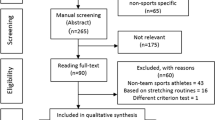Abstract
The objective of this study was to measure the force exerted by 83 trained CPR rescuers and 104 untrained adult laypersons (college students and staff). A bathroom scale was used to measure the force exerted by these subjects with their hands on the bathroom scale in the CPR position. The weight range for both groups was the same. Of the trained rescuers, 60% pressed with more than 125 lbs, whereas only 37% of the laypersons pressed with more than 125 lbs. In view of the American Heart Association (AHA) guidelines (2000) to depress the chest 1.5 to 2 inches, which requires 100–125 lbs, it would appear that most laypersons do not exert enough force for effective CPR.


Similar content being viewed by others
References
AHA Guidelines for cardiopulmonary resuscitation and emergency cardiovascular care. Circulation 2000;102 Suppl I:I22–59
Abella BS, Sandbo N, Vallsalitos PV, et al. Chest compression rates during CPR. Circulation 2005;111:428–4
American Heart Association (AHA). Supplement to Circulation 2005;112 Suppl 114
Bankman IN, Gruben KG, Holperin HR, et al. Identifications of dynamic mechanical parameters of the human chest during CPR. IEEE Trans Biomed Eng 1990;17(2):211–7
Black C, Busutil A, Robertson C. Chest-wall injuries following CPR. Resuscitation 2004;62:339–43
Chiang W-C, Chen W-J, Chen S-Y, et al. Better adherence to the guidelines during CPR through the provision of audio prompts. Resuscitation 2005;64(3):297–301
Geddes LA, Roeder RA, Foster KS, et al. Cyclops Whistler - a noninvasive monitor for the amplitude of the arterial pulse. Cardiovasc Eng 2005;5(2):97–102
Handley AJ, Handley SAJ. Improving CPR performance using an audible feedback system suitable for incorporation into an AED. Resuscitation 2003;57:57–62
Hoke RS, Chamberlain D. Skeletal chest injuries secondary to CPR. Resuscitation 2004;63:322–338
Lederer W, Mair D, Rabl W, etal. Frequency of rib, sternal fracture associated with out-of-hospital CPR. Resuscitation 2004;60:157–62
Milander M, Hiscock PS, Sanders AB, et al. Chest compression and ventilation rates during CPR. Acad Emer Med 1995;2:708–13
Tsitlika JE, Weisfeldt ML, Chandra N, et al. Elastic properties of the human chest during CPR. Crit Care Med 1983;11(9):685–92
Wik L, Johansen JK, Myklebust H, et al. Quality of CPR during out-of-hospital cardiac arrest. JAMA 2005;293(9):299–304
Acknowledgment
The authors wish to thank Kevin Ply, deputy chief of the Purdue University fire department and the others from environmental fire departments for participating in this study. All participants including the college students and staff were volunteers.
Supported by the Purdue University TRASK Fund.
Author information
Authors and Affiliations
Corresponding author
Rights and permissions
About this article
Cite this article
Geddes, L.A., Boland, M.K., Taleyarkhan, P.R. et al. Chest Compression Force of Trained and Untrained CPR Rescuers. Cardiovasc Eng 7, 47–50 (2007). https://doi.org/10.1007/s10558-007-9029-5
Published:
Issue Date:
DOI: https://doi.org/10.1007/s10558-007-9029-5




